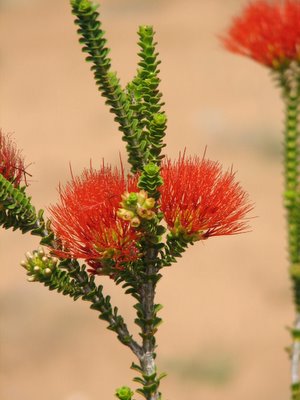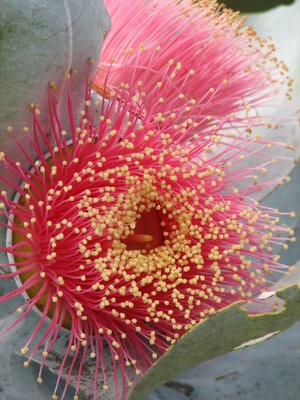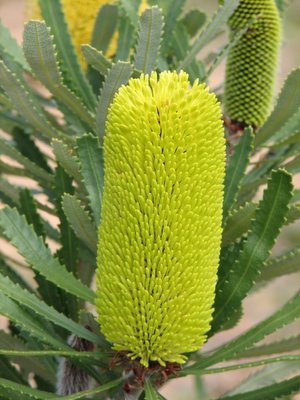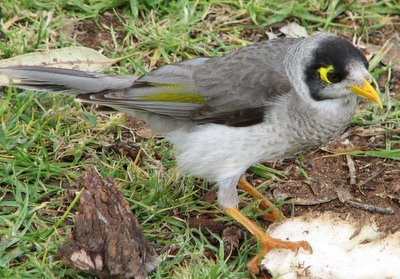Pangarinda Arboretum, Wellington, South Australia
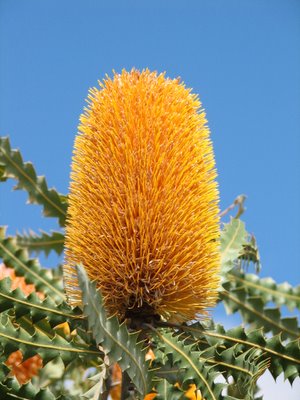
This morning we travelled down river through Tailem Bend to the small town of Wellington, South Australia. This town is near the end of the River Murray where it flows into Lake Alexandrina. From this lake it flows into the Coorong and out to the Southern Ocean.
Just east of the river at Wellington is the Pangarinda Arboretum. This consists of a plantation of Australian native plants established over a decade ago by local members of the Australian Plant Society (APS). The plantation has been planted in sections to represent different plant regimes from different parts of Australia.
Today’s gathering of members of APS was for a special Christmas lunch for members of the three local branches of APS. Members came from the Murray Bridge, Parrakie and Karoonda groups. Also present were members of the family of Ross Foreman who celebrates his 80th birthday tomorrow. Ross and his late wife Pat have been long time members of APS and they have freely given hundreds of volunteer hours of work to the arboretum. After cutting the birthday cake we all moved to another section of the plantation for Ross to open the Foreman Gazebo. This looks over the arboretum to the east and the river to the west.
After the ceremony we all wandered around the plantings looking at the many flowering plants. Some had finished their spring flowering but others, like the banksias, were resplendant in a variety of shapes and colours.
The bird watching was quite good too, with 22 species recorded, despite all the people wandering around. I managed to get some very good flower shots and one good photograph of a thornbill. The following is a list of the birds seen:
White Faced Heron
Pacific Black Duck
Nankeen Kestral
Swamp Harrier
Black Kite
White Ibis
Rock Dove
Peaceful Dove
Crested Pigeon
Galah
Elegant Parrot
Singing Honeyeater
New Holland Honeyeater
Magie Lark
Australian Magpie
Yellow Rumped Thornbill
Common Starling
House Sparrow
Common Blackbird
European Goldfinch
Willie Wagtail
One of the members who regularly does volunteer work there reported to me that Zebra Finches had been breeding in the plantation recently.
Morning Walk
I went for an hour long walk early this morning. I hadn’t intended making a list of birds I saw and heard but the birding was so good this morning that I recorded a list of all the species seen and heard.
For my regular walks I have five different routes. Two of the walks have been added only in the last eighteen months. Three of the routes I have used regularly for many years. I have bird lists for some of these walks over the last 17 years and this information is entered on a birding database.
The highlight of the walk this morning was to see four Varied Sittellas. This species is widespread in this area but they are not common anywhere. I have recorded them on only a few occasions. Unfortunately I didn’t have my camera with me so I cannot show a picture of one. They behave a little like treecreepers, clinging to the tree branches in all kinds of positions. More experienced ornithologists than me have been quite perplexed as to how these delightful little birds seem to be able to hop underneath a branch – and not fall off. They seem to defy gravity!
Another highlight this morning was to hear several Peaceful Doves. Their soft coo-cooing has an almost ventriloquial quality; it can seem to be coming from a hundred metres away but the bird is actually sitting in the tree above you! I did get a photograph of a Peaceful dove several days ago but it was in too much shadow to see it clearly.
Both of these species are occasional visitors to our garden. It is always a delight to hear and see them so close to our home.
A Happy Birthday
It was my birthday last week. I had a really great day. The weather was perfect at about 25 degrees, a bright cloudless sky and a gentle cooling breeze.
My wife suggested that we go out for lunch. We tried a recently opened restaurant called Pomberuk here in Murray Bridge. It is a part of the Aboriginal Cultural Centre. Downstairs there is a museum telling the story of the local Aboriginal people. There are also many paintings featuring local Aboriginal artists. On one side of the gallery and museum there is a viewing window where you can see chocolates being made in The Cottage Box factory.
Upstairs there is a gift shop and the restaurant. You may choose to eat indoors in the main restaurant or out on the balcony. The restaurant overlooks the River Murray, less than 40 metres away. The birdwatching is great from this vantage point, although some birds may be frightened away a little by the noise coming from both bridges.
The restaurant is situated between two of the the three bridges here in Murray Bridge. Near the CBD there is a road bridge and a separate rail bridge. Several kilometres downstream is the newer Swanport Bridge which serves the road bypass on the Adelaide to Melbourne highway. I was quite surprised how little noise coming from the bridges actually reaches one as you sit on the balcony of the restaurant. The food was delicious. And reasonably priced too.

This photograph show two of the three bridges at Murray Bridge.
The road bridge is in the foreground with the rail bridge is in the background.
Pomberuk is on the right in between these two bridges.
After lunch we drove a little distance downstream and found a shady tree to park under. we sat there for nearly half an hour watching the river flow past. Very relaxing.
Here is a list of the birds I saw during that time:
Rock Dove
House Sparrow
Common Starling
Eurasian Coot
Welcome Swallow
Clamorous Reedwarbler
Black Winged Stilt
Black Tailed Native Hen
Silver Gull
Pacific Black Duck
White Plumed Honeyeater
Noisy Miner
Red Wattlebird
Willie Wagtail
Little Raven
Galah
Crested Pigeon
Rainbow Lorikeet
Blackbird
Australian Magpie
Magpie Lark
Galahs on Guard
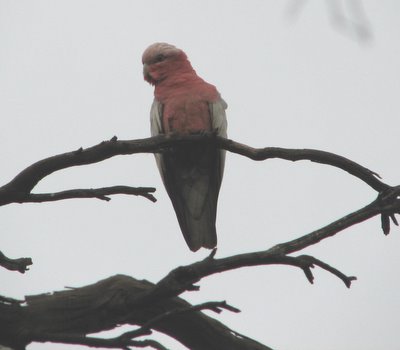
This morning while out in the garden I saw about eight Galahs fly in quietly and settle on the tall mallee tree near the house. I observed them watching me carefully as I tried not to look too conspicuous as I casually went inside to fetch the camera. they were still there when I came out but were very cautious.
I managed to get a few shots of them before they flew off squawking in their usual manner. Perhaps they didn’t like me pointing something up at them. Maybe they were heading off to join the flock I heard calling in the distance. The flock seemed to be quite large; sometimes they can reach into the hundreds.
The shots I managed are not very good photographs. The sky was overcast and the light conditions very poor. Somewhere in my collection of slides I have a magnificent photograph of a pair of Galahs sitting on the remnant of a tree sticking out of the water in one of the lakes at Hattah-Kulkyne National Park in Victoria. The photo was taken with the last rays of sunlight lighting up the rose coloured feathers. I must find that slide, scan it and post it here.
It is a magnificent sight to see a flock of two to three hundred Galahs all gliding and wheeling through the air in unison, the setting sun lighting up their breast feathers like so many rose coloured beacons flaming against the deep blue Australian sky.
Less attractive are the sneaky groups of half a dozen or so that slip under our radar in the early morning light and proceed to demolish the crop on our almond trees weeks before they are ready to pick. Or the brazen individuals that sit atop the pear trees, nibbling around the stem of each piece of fruit, again, only weeks before they are ripe.
Updated Nov 2013.
Gluepot Bird Sanctuary – more photographs
I’ve just been editing some of the photographs I took on my recent visit to Gluepot Bird Sanctuary near Waikerie in South Australia.
Yellow Plumed Honeyeater
Yellow Plumed Honeyeaters seemed to be almost everywhere, and very common wherever the mallee was in flower.
Chestnut Quail-Thrush
The striking plumage makes for excellent camouflage, but this individual was quite obvious on the bare earth.
